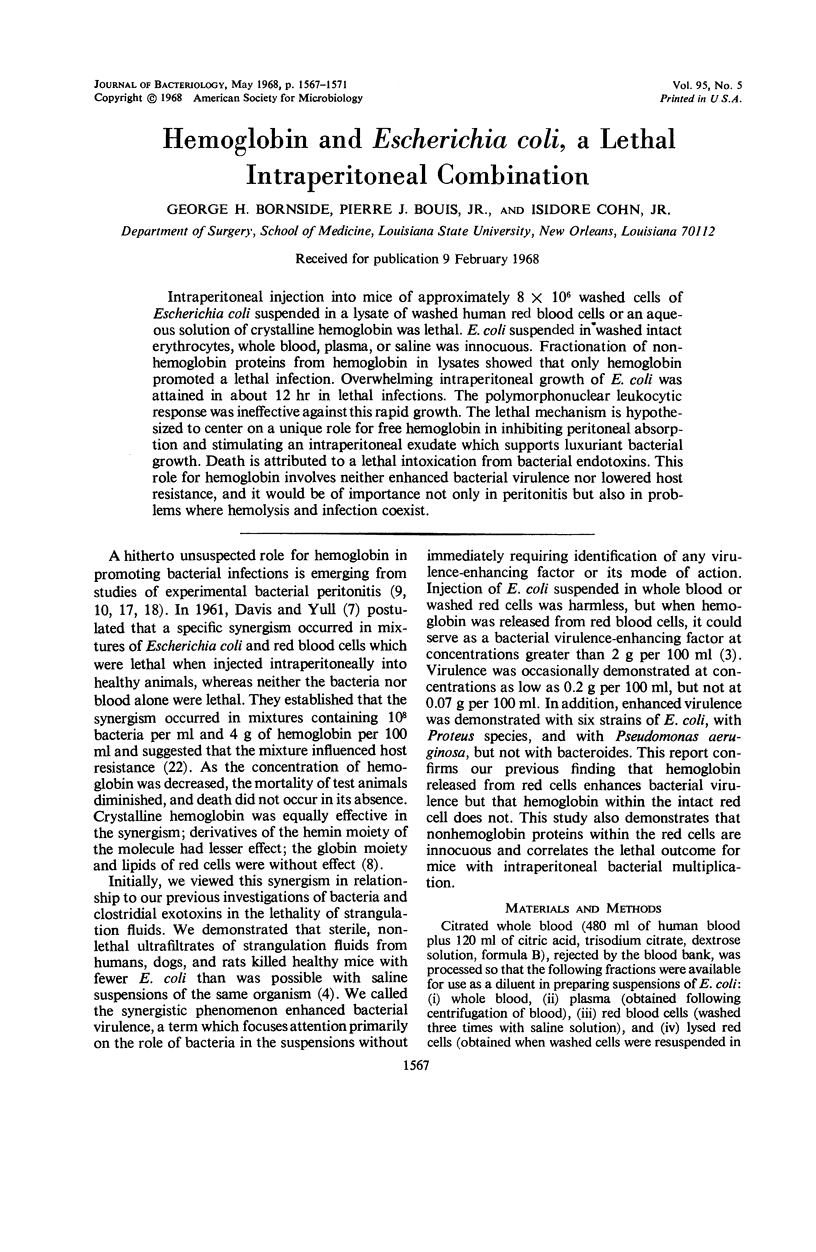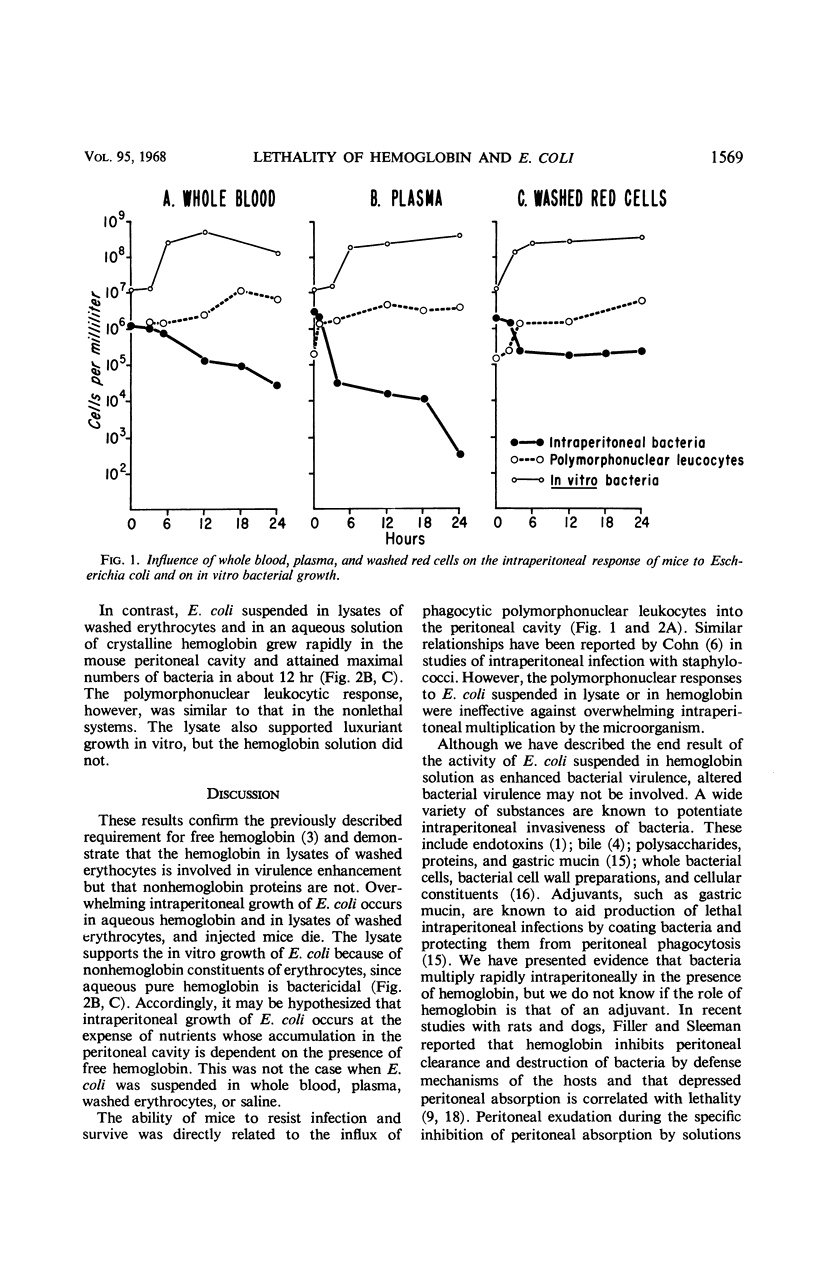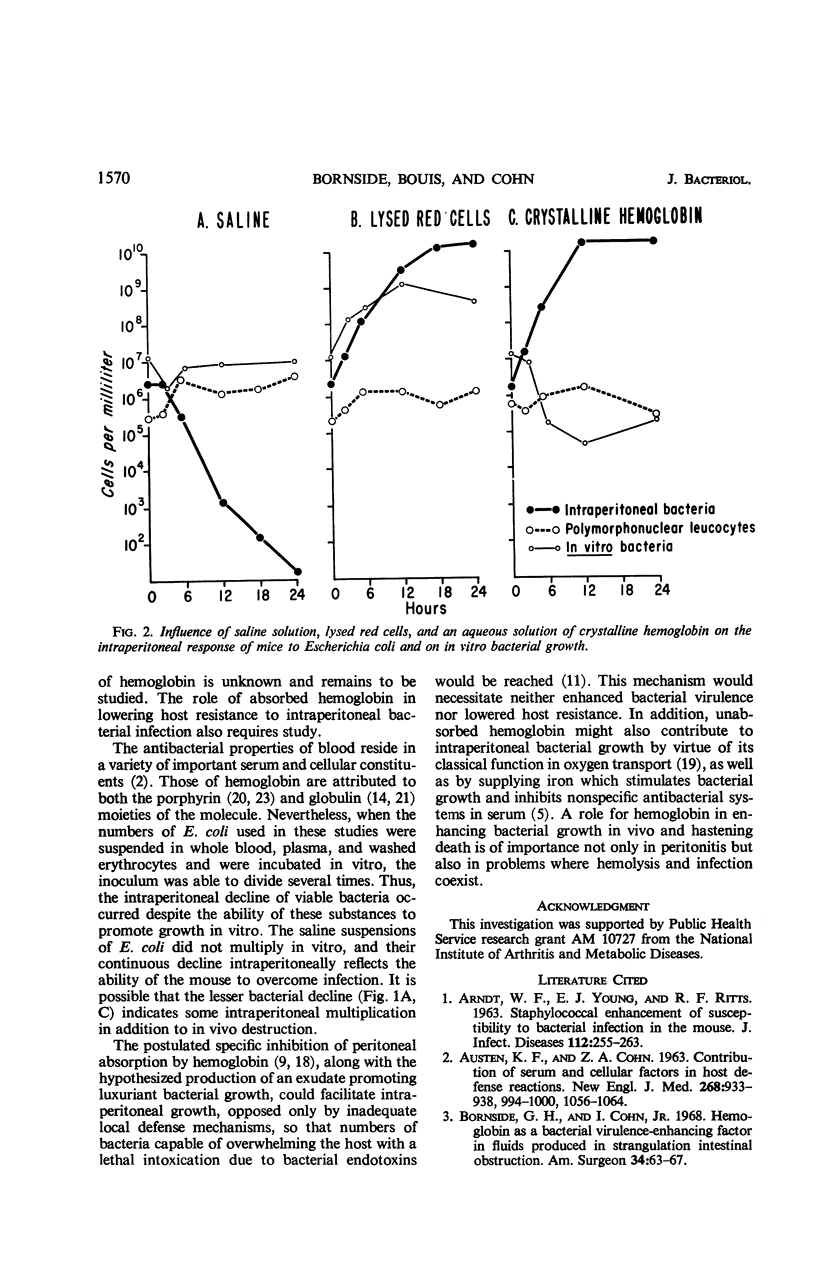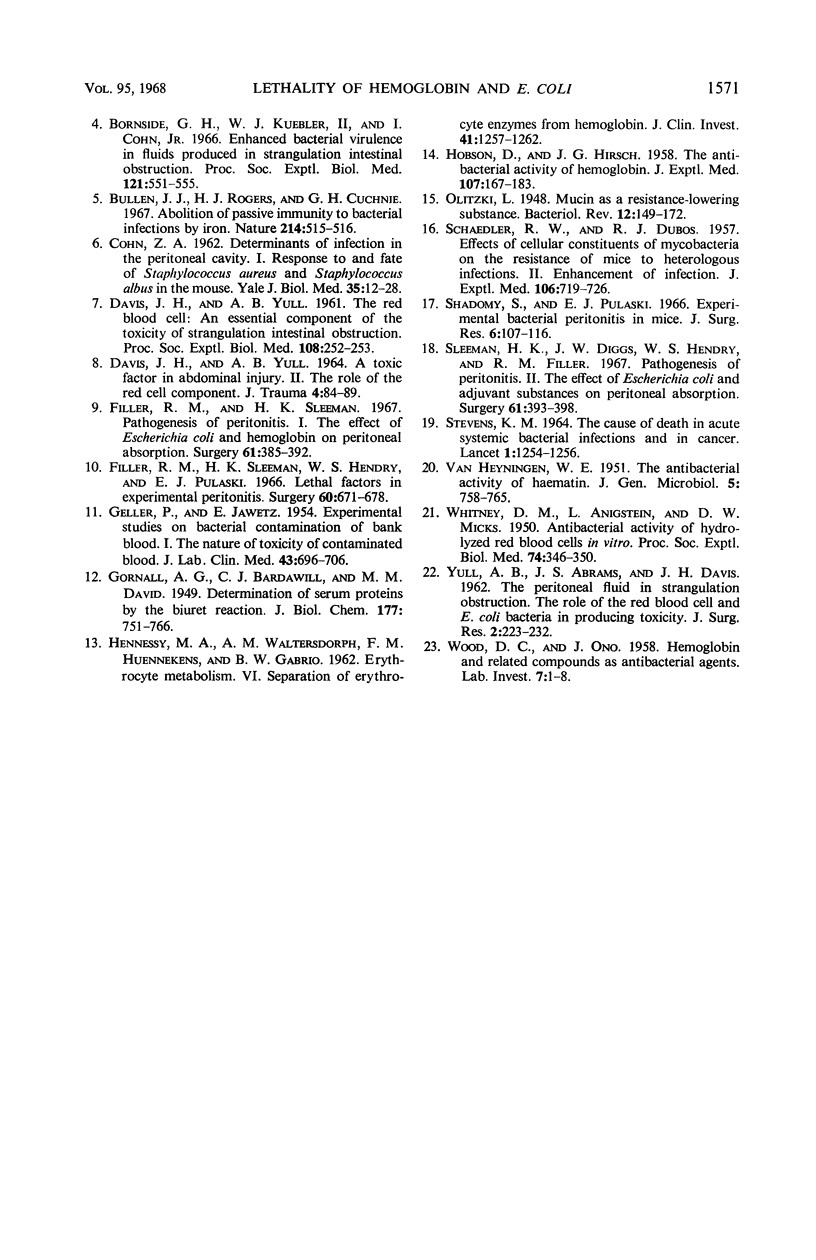Abstract
Intraperitoneal injection into mice of approximately 8 × 106 washed cells of Escherichia coli suspended in a lysate of washed human red blood cells or an aqueous solution of crystalline hemoglobin was lethal. E. coli suspended in washed intact erythrocytes, whole blood, plasma, or saline was innocuous. Fractionation of non-hemoglobin proteins from hemoglobin in lysates showed that only hemoglobin promoted a lethal infection. Overwhelming intraperitoneal growth of E. coli was attained in about 12 hr in lethal infections. The polymorphonuclear leukocytic response was ineffective against this rapid growth. The lethal mechanism is hypothesized to center on a unique role for free hemoglobin in inhibiting peritoneal absorption and stimulating an intraperitoneal exudate which supports luxuriant bacterial growth. Death is attributed to a lethal intoxication from bacterial endotoxins. This role for hemoglobin involves neither enhanced bacterial virulence nor lowered host resistance, and it would be of importance not only in peritonitis but also in problems where hemolysis and infection coexist.
Full text
PDF




Selected References
These references are in PubMed. This may not be the complete list of references from this article.
- AUSTEN K. F., COHN Z. A. Contribution of serum and cellular factors in host defense reactions. I. Serum factors in host resistance. N Engl J Med. 1963 May 2;268:994–contd. doi: 10.1056/NEJM196305022681807. [DOI] [PubMed] [Google Scholar]
- Bornside G. H., Cohn I., Jr Hemoglobin as a bacterial virulence-enhancing factor in fluids produced in strangulation intestinal obstruction. Am Surg. 1968 Jan;34(1):63–67. [PubMed] [Google Scholar]
- Bornside G. H., Kuebler W. J., 2nd, Cohn I., Jr Enhanced bacterial virulence in fluids produced in strangulation intestinal obstruction. Proc Soc Exp Biol Med. 1966 Feb;121(2):551–555. doi: 10.3181/00379727-121-30828. [DOI] [PubMed] [Google Scholar]
- Bullen J. J., Rogers H. J., Cushnie G. H. Abolition of passive immunity to bacterial infections by iron. Nature. 1967 Apr 29;214(5087):515–516. doi: 10.1038/214515a0. [DOI] [PubMed] [Google Scholar]
- COHN Z. A. Determinants of infection in the peritoneal cavity. I. Response to and fate of Staphylococcus aureus and Staphylococcus albus in the mouse. Yale J Biol Med. 1962 Aug;35:12–28. [PMC free article] [PubMed] [Google Scholar]
- DAVIS J. H., YULL A. B. A TOXIC FACTOR IN ABDOMINAL INJURY. II. THE ROLE OF THE RED CELL COMPONENT. J Trauma. 1964 Jan;4:84–90. [PubMed] [Google Scholar]
- DAVIS J. H., YULL A. B. The red blood cell: an essential component of the toxicity of strangulation intestinal obstruction. Proc Soc Exp Biol Med. 1961 Oct;108:252–253. doi: 10.3181/00379727-108-26906. [DOI] [PubMed] [Google Scholar]
- Filler R. M., Sleeman H. K. Pathogenesis of peritonitis. I. The effect of Escherichia coli and hemoglobin on peritoneal absorption. Surgery. 1967 Mar;61(3):385–392. [PubMed] [Google Scholar]
- Filler R. M., Sleeman H. K., Pulaski E. J., Hendry W. S. Lethal factors in experimental peritonitis. Surgery. 1966 Sep;60(3):671–678. [PubMed] [Google Scholar]
- GELLER P., JAWETZ E. Experimental studies on bacterial contamination of bank blood. I. The nature of toxicity of contaminated blood. J Lab Clin Med. 1954 May;43(5):696–706. [PubMed] [Google Scholar]
- HENNESSEY M. A., WALTERSDORPH A. M., HUENNEKENS F. M., GABRIO B. W. Erythrocyte metabolism. VI. Separation of erythrocyte enzymes from hemoglobin. J Clin Invest. 1962 Jun;41:1257–1262. doi: 10.1172/JCI104588. [DOI] [PMC free article] [PubMed] [Google Scholar]
- HODSON D., HIRSCH J. G. The antibacterial activity of hemoglobin. J Exp Med. 1958 Feb 1;107(2):167–183. doi: 10.1084/jem.107.2.167. [DOI] [PMC free article] [PubMed] [Google Scholar]
- Olitzki L. MUCIN AS A RESISTANCE-LOWERING SUBSTANCE. Bacteriol Rev. 1948 Jun;12(2):149–172. doi: 10.1128/br.12.2.149-172.1948. [DOI] [PMC free article] [PubMed] [Google Scholar]
- SCHAEDLER R. W., DUBOS R. J. Effects of cellular constituents of mycobacteria on the resistance of mice to heterologous infections. II. Enhancement of infection. J Exp Med. 1957 Nov 1;106(5):719–726. doi: 10.1084/jem.106.5.719. [DOI] [PMC free article] [PubMed] [Google Scholar]
- STEVENS K. M. CAUSE OF DEATH IN ACUTE SYSTEMIC BACTERIAL INFECTIONS AND IN CANCER. Lancet. 1964 Jun 6;1(7345):1254–1256. doi: 10.1016/s0140-6736(64)91876-8. [DOI] [PubMed] [Google Scholar]
- Shadomy S., Pulaski E. J. Experimental bacterial peritonitis in mice. J Surg Res. 1966 Mar;6(3):107–116. doi: 10.1016/s0022-4804(66)80063-x. [DOI] [PubMed] [Google Scholar]
- Sleeman H. K., Diggs J. W., Hendry W. S., Filler R. M. Pathogenesis of peritonitis. II. The effect of Escherichia coli and adjuvant substances on peritoneal abosrption. Surgery. 1967 Mar;61(3):393–398. [PubMed] [Google Scholar]
- VAN HEYNINGEN W. E. The antibacterial activity of haematin. J Gen Microbiol. 1951 Oct;5(4):758–765. doi: 10.1099/00221287-5-4-758. [DOI] [PubMed] [Google Scholar]
- WHITNEY D. M., ANIGSTEIN L., MICKS D. W. Antibacterial activity of hydrolyzed red blood cells in vitro. Proc Soc Exp Biol Med. 1950 Jun;74(2):346–350. doi: 10.3181/00379727-74-17902. [DOI] [PubMed] [Google Scholar]
- WOOD D. C., ONO J. Hemoglobin and related compounds as antibacterial agents. Lab Invest. 1958 Jan-Feb;7(1):1–8. [PubMed] [Google Scholar]
- YULL A. B., ABRAMS J. S., DAVIS J. H. The peritoneal fluid in strangulation obstruction. The role of the red blood cell and E. coli bacteria in producing toxicity. J Surg Res. 1962 Jul;2:223–232. doi: 10.1016/s0022-4804(62)80014-6. [DOI] [PubMed] [Google Scholar]


